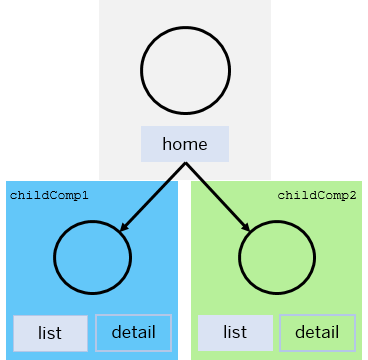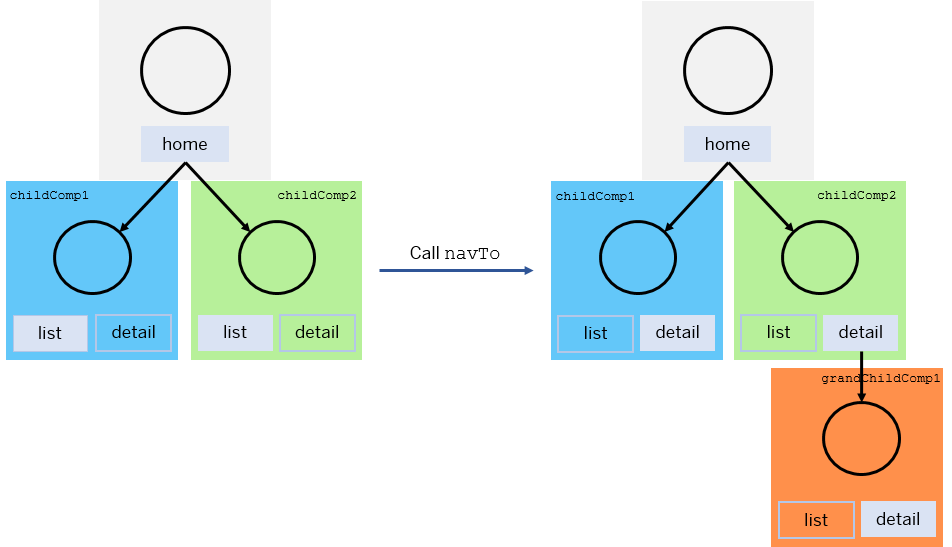Navigate with Nested Components
navTo method in the sap.ui.core.routing.Router
class enables you to define a set of parameters to navigate to a specific route.To use the navTo method for navigation with nested components, you need
to call the method with the following information:
-
Name of the route
-
Parameters for the route
-
Target information for the route name and the parameters in the nested components (optional)
-
Information, whether the current browser hash is replaced or a or a new hash entry is set (optional)
For more information, sap.ui.core.routing.Router.navTo in the API
Reference.
The call triggers the following actions in the given order:
-
For the new hash, the variable placeholders in the route's pattern are replaced with the given parameters. If the method is called with information for a router in nested components, the targets with type
Componentare loaded to compose the hash parts of theseComponenttargets. -
The new hash is set to the browser.
-
The browser fires a
hashchangeevent. -
The router processes the event and propagates the event along the hierarchy which was built while loading the nested components.
-
Each router checks its own hash part and informs the matched route. The matched route displays the targets which are configured for this route.
-
Each targets loads its
VieworComponentand adds it to the configuredcontrolAggregationof thecontrolIdcontainer. -
The router fires a
routeMatchedevent and the route fires amatchedevent to inform the application that the hash change is completed.
Using navTo for Passing
Information to a Nested Router
For passing information about the route
name and parameters for a nested router, you use the
oComponentTargetInfo parameter of the navTo
method. By this, the router in nested components can show the targets which are
configured to one specific route instead of giving the router an empty hash as
default. This oComponentTargetInfo parameter contains key-value
pairs with the name of a Component target as the key, and the value
must be an object which has at least the route name in the route
property. The route name should be matched within the router of this component with
the parameters for this route. If this route has again Component
targets, the property componentTargetInfo can be used to specify
the route information. The value of the componentTargetInfo
property has the same structure as the oComponentTargetInfo
parameter of the navTo method.
The following example shows a
top level router with a "home" route with two Component
targets:
-
ComponenttargetchildComp1with the following two defined routes:-
Route
list: Has an empty string hash as pattern and shows a list of items -
Route
detail: Shows the details for an item
-
-
ComponenttargetchildComp2with the following two defined routes:-
Route
list: Has an empty string hash as pattern and shows a list of items -
Route
detail: Shows the details for an item which displays again a nestedComponenttargetgrandChildComp1
-
The grandChildComp1 target has the following two routes
defined:
-
Route
list: Has an empty string hash as pattern and shows a list of items -
Route
detail: Shows the details for an item
When the home route in the top level router is matched, the
Component targets childComp1 and
childComp2 are loaded and shown. Each of them receives an empty
string hash as default, and so the list routes of their routers are
matched.

By using the
navTo method, specific route information can be given to
multiple nested components and, if available, their deep nested components. For
example, the detail routes in both Component
targets childComp1 and childComp2 need to be
matched. Since the detail route of target
childComp2 loads another nested component
(grandChildComp1), it is also possible to match the
detail route in the deep nested component
grandChildComp1 with the same navTo call, see
the following code
snippet.
oRouter.navTo("home", {
// this route doesn't need any parameter
}, {
childComp1: {
route: "detail",
parameters: {
...
}
},
childComp2: {
route: "detail",
parameters: {
...
},
componentTargetInfo: {
grandChildComp1: {
route: "detail",
parameters: {
...
}
}
}
}
});After
the navTo call, the route state of each router looks as depicted in
the following figure:

Navigating Away From a Nested Component
When a new route is matched within a router and a
Component target was displayed within the old route, it is
necessary to avoid that this Component target still reacts to
unnecessary events such as hashChanged. For example, after
switching from the detail route to the list route
within the Component target childComp2, the deep
nested Component target grandChildComp1 is no
longer relevant for the UI. This is shown in the following figure:

To avoid this,
-
the hash part is removed from the browser hash.
-
the router is stopped, so that it no longer reacts to the
hashChangedevent.